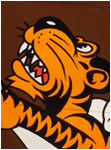 |
| ARTIFACTS FROM SIGNIFICANT AIRCRAFT... | |||
|
Collect a Piece of History
|
|||
 |
 |
 |
 |
 |
 |
 |
|
| Flying Tiger click on images to enlarge |
|||
| "FLYING TIGERS" P-40 Warhawk Nose Art Display The Shark Toothed P-40 was the most recognized fighter of World War II. The Shark Teeth was adopted from a German fighter by the British on their Lend-Lease P-40 Tomahawks, but the Flying Tigers made the most of it during the early days of the war. The Flying Tigers' success in China seemed to be our only wins after Pearl Harbor and the US entry into World War II. The famous winged Flying Tiger going through a V for victory was designed by Walt Disney Studios especially for the AVG. We have crafted an authentic reproduction of Flying Tigers Nose Art. Warbird Collections' artists have crafted the most realistic looking reproduction World War II Nose Art available. They are full sized, museum quality and are very limited editions; there will only be a few ever made. Each is numbered with archival history. The Nose Art display is reproduced from an actual P-40 Warhawk aircraft. We have faithfully reproduced all the surface details including flush rivets, panel seams, patch panels, dimples and scrapes. The weathered and battle hardened painted surface is especially realistic. The Warbird Collections Flying Tigers P-40 Warhawk Nose Art Reproduction is a Tribute to the airplane, the pilots and the crews that flew and maintained them. SIZE: 12 feet long, 5 feet high, 18 inches deep; approx. 150 pounds. Each display piece has attachment (hard points) molded in the back for hanging on your wall or hanger. PRICE: $7,000 ea. SHIPPING & CRATING: additional, quoted on order. FOB: California HISTORY B-26 MARAUDER MEDIUM BOMBER The B-26B had the lowest attrition rate of any American bomber in the ETO. The original 1939 specifications called for a high speed, high performance aircraft. The Marauder went from paper to flying plane in less than two years. However, the small wing area resulted in poor low-speed handling and landing; it's early reputation as "Widow Maker" with a high number of training crashes ("One a Day in Tampa Bay"). The Truman Commission, headed by Senator Truman (soon to be Vice President), investigated the B-26 Safety Record resulting in modifications such as longer wings (B-26B) and additional training. As with most US designed and built WW II aircraft, the B-26 was a tough airplane. It could receive substantial damage and keep flying. PRODUCTION: 5,266 There are very few B-26 Marauders left and only one that is air worthy; last known to be owned by aircraft collector Kermit Weeks' "Fantasy of Flight". P-40 WARHAWK FIGHTER The United States needed modern high performance fighters in 1937 as they watched the World War growing in Europe and Japan. The P-40 Warhawk (a major modification of the older P-36 Hawk), the P-39 Fighter and the radical P-38 Lightning Twin Engine Fighter were ordered about the same time. The P-40 first flew in 1938 and 13,738 were built by the time production ceased in November 1944. The lack of a two-stage supercharger limited the P-40 Warhawk to ground attack and other missions that did not require high altitude combat such as needed in ETO. The P-40 served in five theaters; China, Mediterranean, Southeast Asia, and Eastern Europe. The US supplied Britain with the P-40, called the Tomahawk, as part of the Lend-Lease Program. THE FLYING TIGERS The Flying Tigers were a group of ex-American pilots and crew that were recruited by Retired Army Air Corps (USAAF) Captain Claire Chennault in the winter of 1940-1941 to help defend the Republic of China from the invading Japanese. The Americans were required to resign their positions in the US military, as The United States was officially a neutral non-combatant nation in the growing World War II. They become employees of a private contractor, Central Aircraft Manufacturing Company, for instruction and training duties in China. The American Volunteer Group (AVG) sailed to China during the summer-fall of 1941, to be engaged in combat within days of the attack on Pearl Harbor. The P-40 Warhawk's early availability made it the choice for the AVG, the famous Flying Tigers. One hundred Tomahawks/Warhawks were diverted from the British Lend-Lease production run and sold to the private contractor. Retired Army Air Corps Captain Chennault conducted intensive training of his Group to emphasize the strengths of the P-40 Warhawk against the strengths and weaknesses of the Japanese aircraft. The result was the overwhelming kill rate against numerically superior Japanese forces. The AVG was disbanded on 4 July 1942 and absorbed into the USAAF 23rd Fighter Group and later into the 14th Air Force commanded by General Claire Chennault. |
|||
| Custom Commissions Accepted Contact Pat McGinnis for more information Tel: 1 805-895-7793 Fax: 1 805-967-0109 email: info@warbirdcollections.com |
|||
| HOME | ABOUT | HISTORY | GALLERY | |||||||
| MAILING LIST | LINKS | ORDER INFO | CONTACT | |||||||